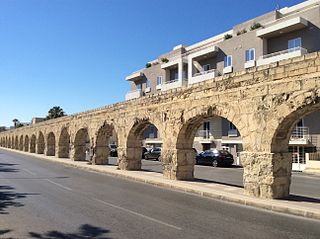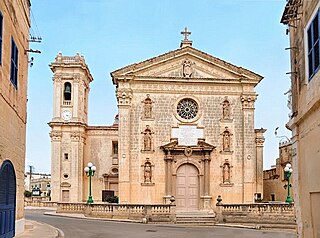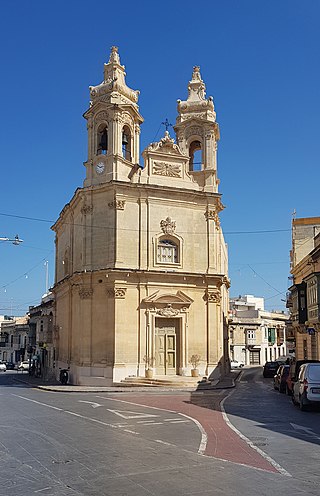
San Anton Palace is a palace in Attard, Malta, that currently serves as the official residence of the president of Malta. It was originally built in the early 17th century as a country villa for Antoine de Paule, a knight of the Order of St. John. It was expanded into a palace following de Paule's election as Grand Master in 1623.

For people with the surname, see Dingli (surname).

Fort Manoel is a star fort on Manoel Island in Gżira, Malta. It was built in the 18th century by the Order of Saint John, during the reign of Grand Master António Manoel de Vilhena, after whom it is named. Fort Manoel is located to the north west of Valletta, and commands Marsamxett Harbour and the anchorage of Sliema Creek. The fort is an example of Baroque architecture, and was designed with both functionality and aesthetics in mind.

Fort Saint Elmo is a star fort in Valletta, Malta. It stands on the seaward shore of the Sciberras Peninsula that divides Marsamxett Harbour from Grand Harbour, and commands the entrances to both harbours along with Fort Tigné and Fort Ricasoli. It is best known for its role in the Great Siege of Malta in 1565.

St Augustine Church is one of the churches built during the creation of the new city of Valletta, Malta.

The Wignacourt Aqueduct is a 17th-century aqueduct in Malta, which was built by the Order of Saint John to carry water from springs in Dingli and Rabat to the newly built capital city Valletta. The aqueduct carried water through underground pipes and over arched viaducts across depressions in the ground.

The Basilica of St Dominic or also known as the Basilica of Our Lady of Safe Haven and St Dominic is one of the three parish churches of Valletta, Malta. It is administered by the Dominican Order whose convent is located behind the church.

The Church of Our Lady of the Pillar is a 17th-century church located in Valletta, Malta. The church was built as the church of the Aragonese knights and modeled according to the plans of the architect Romano Carapecchia. The church is listed on the National Inventory of the Cultural Property of the Maltese Islands.

The fortifications of Valletta are a series of defensive walls and other fortifications which surround Valletta, the capital city of Malta. The first fortification to be built was Fort Saint Elmo in 1552, but the fortifications of the city proper began to be built in 1566 when it was founded by Grand Master Jean de Valette. Modifications were made throughout the following centuries, with the last major addition being Fort Lascaris which was completed in 1856. Most of the fortifications remain largely intact today.

The fortifications of Senglea are a series of defensive walls and other fortifications which surround the city of Senglea, Malta. The first fortification to be built was Fort Saint Michael in 1552, and the majority of the fortifications were built over the next decade when it was founded by Grand Master Claude de la Sengle. Modifications continued until the 18th century, but large parts of the fortifications were demolished between the 19th and 20th centuries. Today, all that remain of Senglea's fortifications are the seaward bastions and part of the land front.

Saint Mary Magdalene Chapel is a Roman Catholic chapel in the limits of Dingli, Malta, dedicated to Mary Magdalene. It overlooks the Dingli Cliffs, and is therefore commonly known as il-kappella tal-irdum. The chapel was built in 1646 on the site of an earlier one which had existed since at least the 15th century. Its simple architecture is typical of Maltese wayside chapels.

The Parish Church of Saint Mary, commonly known as il-Knisja l-Qadima is a Roman Catholic parish church in Birkirkara, Malta, dedicated to the Assumption of Mary. It was built in the 17th century, and it has a Renaissance design attributed to the architects Vittorio Cassar and Tommaso Dingli.

The Parish Church of Saint Mary is a Roman Catholic parish church in Attard, Malta, dedicated to the Assumption of Mary. Built between 1613 and 1624, the church is attributed to the architect Tommaso Dingli and it is regarded as the finest Renaissance church in Malta. It still retains its original design, with the exception of a belfry and two sacristies which were added in the 18th and 19th centuries.

The Parish Church and Sanctuary of Our Lady of Graces is a Roman Catholic parish church in Żabbar, Malta, dedicated to Our Lady of Graces. The church was originally built between 1641 and 1696 to designs of the Renaissance architect Tommaso Dingli. Its façade, an outstanding example of Maltese Baroque architecture, was built in 1738 to designs of Giovanni Bonavia. The dome was rebuilt in the early 19th century after it had been damaged during the French blockade of 1798–1800, and it was rebuilt again in the first half of the 20th century to designs of Giuseppe Pace.

Balluta Buildings is an Art Nouveau apartment block overlooking Balluta Bay in St Julian's, Malta. It was built in 1928 for the Marquis John Scicluna, and it was constructed to designs of Giuseppe Psaila. The building is considered to be among the finest of the few surviving examples of Art Nouveau architecture in Malta.

The Old Church of St Sebastian, commonly known as il-knisja ż-żgħira, is a Roman Catholic church in Qormi, Malta, dedicated to Saint Sebastian. It was built between 1880 and 1890 near a statue of the saint which had been erected in 1815 to commemorate deliverance from a plague epidemic in 1813. It was a parish church between 1935 and the 1980s, when a larger parish church with the same dedication was built nearby. The building was only formally consecrated in 2019, and it is now used as an adoration chapel.
The Old Church of St Domenica is a ruined Roman Catholic parish church in Dingli, Malta, which was dedicated to Saint Domenica.

The Parish Church of the Assumption of the Blessed Virgin Mary into Heaven is a Roman Catholic parish church in Dingli, Malta, dedicated to the Assumption of Mary. It was constructed in various stages between 1903 and 1973 on the site of a previous church which had been built between 1678 and 1680.

The Chapel of St Anthony of Padua is a Roman Catholic chapel located in Fort Manoel on Manoel Island in Gżira, Malta. It was completed in 1727 as an integral part of the fort, and it was partially destroyed by aerial bombardment in 1942 during World War II. The chapel was reconstructed as part of a restoration project and it was completed in 2009.

St Catherine's Monastery is a monastery in Valletta, Malta which houses cloistered nuns of the Second Order of Saint Augustine. It incorporates the Church of the Presentation of Our Lady, which is more commonly known as the Church of St Catherine. The church and monastery were built in the 18th century and they replaced a previous monastery which had been housed in a 16th-century palace.




















